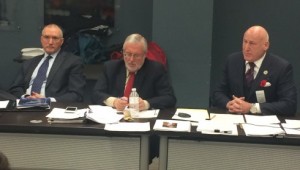 While the federal compliance rules have disappeared for the time being, the need for states to actively reduce carbon emissions from power production has not. How the states move forward is anyone's guess. However, the stay provides them an opportunity to take a new look at the carbon offsets that existing nuclear plants provide, which they weren't encouraged to do under the CPP rules.
While the federal compliance rules have disappeared for the time being, the need for states to actively reduce carbon emissions from power production has not. How the states move forward is anyone's guess. However, the stay provides them an opportunity to take a new look at the carbon offsets that existing nuclear plants provide, which they weren't encouraged to do under the CPP rules.
"The value of nuclear isn't equally understood from state to state," said Donald R. Hoffman, co-chair of the ANS Special Committee on Nuclear in the States, which developed the toolkit. At a press briefing in Washington D.C. on February 8, he urged states to consider "the unique value of nuclear from the perspective of energy, the economy, and the environment."
Special Committee co-chair Dr. Peter Lyons noted that with cheaper gas, and renewable tax credits and mandates in some states, nuclear power is often "economically disadvantaged." Put plainly, there is not a level playing field for all low-carbon energy sources, and as in the case of gas, low immediate cost is taking precedence over clean energy and the long-term higher costs of keeping carbon-spewing sources.
Beyond clean air, Dr. Lyons stressed that consideration also must be given to the broader economic advantages of a strong nuclear program. "It allows the U.S. to export its safety and nonproliferation standards around the world," he said.
Committee member and contributing author of the toolkit Edward Kee noted that the information will be useful to states working on a bi-partisan consensus on how to protect current nuclear energy assets.
Now is the time to prevent the pause in planning that some states may take in response to the CPP being taken out of the equation. There are tools available from ANS and others to help decision makers understand all of the ramifications of closing current plants, and the benefits of adding new plants. It's up to the stakeholders to use them.
Tari Marshall is the Director of Communications and Outreach at the American Nuclear Society. Follow ANS on Twitter and Facebook. Keep up with the news from ANS on What's New.


 While the federal compliance rules have disappeared for the time being, the need for states to actively reduce carbon emissions from power production has not. How the states move forward is anyone's guess. However, the stay provides them an opportunity to take a new look at the carbon offsets that existing nuclear plants provide, which they weren't encouraged to do under the CPP rules.
While the federal compliance rules have disappeared for the time being, the need for states to actively reduce carbon emissions from power production has not. How the states move forward is anyone's guess. However, the stay provides them an opportunity to take a new look at the carbon offsets that existing nuclear plants provide, which they weren't encouraged to do under the CPP rules.